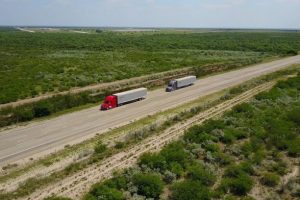Daimler Trucks North America (DTNA) has announced a truck platooning trial that will take place on selected highways in Oregon and Nevada.
The move follows successful trials on DTNA’s proving ground in Madras, Oregon, and the granting of permission by the Oregon Department of Transportation (ODOT) for real-world trials.
There has been significant interest in platooning over the last few years, which involves two or more trucks travelling together with the following trucks operating autonomously to mirror the actions of the lead vehicle. Platooning can save significant amounts of fuel, given the lower safe distances between vehicles that are possible and the resulting drop in air drag, compared to normal driving.
In the first step, called ‘pairing’, the company’s platooning technology will be tested with two connected Freightliner New Cascadia articulated combinations.
The technology to be used was operated successfully by Mercedes-Benz Trucks in the European Truck Platooning Challenge 2016.
Roger Nielsen, president and CEO of Daimler Trucks North America, said: “We see growing customer interest in platooning. This technology stands for more efficiency and safety. Platooning technology is not meant to replace drivers – it’s designed to help drivers.
“When the world is ready for platooning, DTNA will have a proven solution," added Nielsen. "Right now, we are driving Freightliners in platoons every day. I have personally driven one of our trucks in a connected mode. My experience has been impressive.”
The announcement was made at this week’s North American Commercial Vehicle Show.
The company said it was working to understand how platooning technology might impact on fleet operations, including dispatch, logistics and driver training.
Daimler’s Freightliner and Western Star brands combined account for a 40% market share in the North American truck market.
In the upcoming test, Daimler will use wi-fi-based vehicle-to-vehicle communication (V2V) that will interact with Freightliner's Detroit Assurance 4.0 driver assistance systems, featuring Adaptive Cruise Control, Lane Departure Assist and Active Brake Assist 4.
This technology not only offers potential fuel savings when two or more trucks are following each other but also raises safety levels, as V2V reaction times have dropped to around 0.2-0.3 seconds, while humans normally need at least one second.
And prior to that, in January, Scania and Toyota started a truck platooning trial in Singapore.


































